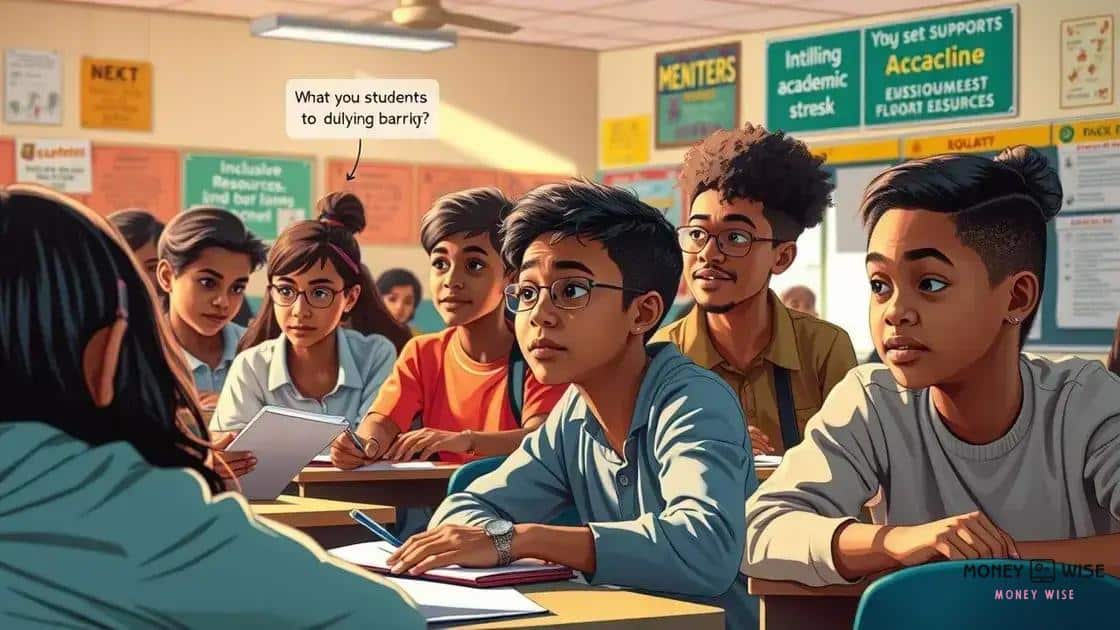Impact of federal education policies on minority students

The impact of federal education policies on minority students is significant, as these policies aim to address inequities, promote inclusivity, and ensure access to quality education for underrepresented groups.
Impact of federal education policies on minority students is a crucial issue shaping educational outcomes today. Have you ever wondered how these policies actually affect students’ lives? Let’s dive into the details.
Overview of federal education policies
Federal education policies play a significant role in shaping the educational landscape for all students, and they are crucial for addressing issues of equity and access. Understanding these policies helps us see how they affect schools and communities, especially for minority students.
Key Federal Education Policies
Several policies have been enacted over the years that directly impact education. These policies aim to provide fair opportunities for all students, regardless of their background. Let’s explore some important ones:
- No Child Left Behind (NCLB) – This policy was aimed at closing the achievement gap and increasing accountability among schools.
- Every Student Succeeds Act (ESSA) – This act replaced NCLB and focused on state control over education while still aiming to assist disadvantaged students.
- Individuals with Disabilities Education Act (IDEA) – This policy ensures that students with disabilities receive a free and appropriate public education.
These policies reflect a commitment to ensure all students can succeed in their educational journeys. As we delve deeper, it’s vital to recognize their implications.
Impact on Minority Students
Implementing these policies has led to various outcomes, both positive and negative. For minority students, such policies have often aimed at improving access to quality education. However, they sometimes do not deliver equitable results.
Challenges such as systemic inequalities may persist. Schools in lower-income areas often struggle to provide the same resources available to more affluent ones. Thus, while federal education policies seek to promote fairness, there are factors that hinder true equity.
Current Trends in Education Policy
Recently, there’s been a push for more inclusive policies that consider the unique experiences of minority groups. Research shows that community involvement can improve educational outcomes significantly. Educators and policymakers are working together to create a more engaging environment for students.
With ongoing discussions about education reform, it is essential to keep pushing for policies that support all students. We’re seeing a shift toward more culturally responsive teaching and strategies that engage diverse learners.
By understanding these policies and their impact on minority students, we can advocate for changes that promote equity and inclusion in education.
Historical context and evolution
The historical context of federal education policies is crucial to understand their evolution and impact on minority students. These policies have been shaped by social movements, legal challenges, and shifts in public opinion over decades.
Key Historical Events
The evolution of education policies began as a response to increased awareness of inequities in the education system. The Brown v. Board of Education decision in 1954 was a landmark case that declared racial segregation in public schools unconstitutional. This ruling opened the door for further reforms aimed at achieving equity.
- The Civil Rights Movement prompted significant changes in policies aimed at eliminating discrimination.
- The Elementary and Secondary Education Act (ESEA), passed in 1965, aimed to provide federal funding to schools serving low-income students.
- Title IX legislation in 1972 ensured that both genders received equitable treatment in education.
These events reflect a growing recognition of the need for equitable education for all individuals, particularly minority groups. As policies progressed, they were often responses to the challenges faced by underrepresented students.
Evolution of Education Policies
Over the years, federal education policies have changed to address new challenges in the education system. The shift from the No Child Left Behind Act to the Every Student Succeeds Act highlights this evolution. ESSA emphasizes state control and flexibility while maintaining the goal of supporting disadvantaged students.
Furthermore, ongoing debates about reform continue to shape the landscape of education policy. As society evolves, these policies must adapt to better meet the needs of diverse student populations. Having in mind the effects of federal education policies, stakeholders are increasingly advocating for more inclusive approaches that recognize the unique challenges faced by minority students.
With a history marked by significant milestones, the journey toward educational equity is ongoing, and it impacts the future of countless students across the nation.
Effects on minority student enrollment
Federal education policies significantly influence minority student enrollment. These policies can either promote inclusivity or create barriers, shaping the opportunities available for underrepresented groups.
Positive Effects of Federal Policies
Some policies have had a positive impact on increasing enrollment among minority students. Programs that provide funding and resources to disadvantaged schools have helped improve educational access. Affirmative measures, such as scholarships and targeted outreach initiatives, further encourage minority students to pursue higher education.
- Increased Funding: Federal programs often provide funds that improve facilities and resources at schools with high minority populations.
- Outreach Programs: Initiatives aimed at raising awareness about educational opportunities can motivate minority families to seek enrollment.
- Affirmative Action: Policies that promote equality in college admissions have enabled more minority students to gain access to higher education.
These efforts illustrate the government’s commitment to enhancing opportunities for all students, particularly those from marginalized backgrounds.
Challenges Faced by Minority Students
Despite these positive efforts, challenges persist that can hinder minority student enrollment. Systemic issues such as poverty, discrimination, and limited access to quality education still exist. Minority students may face logistical barriers, such as transportation issues or lack of support systems within their schools.
Ongoing disparities in educational funding often mean that minority students do not receive the same quality of education as their peers in more affluent areas. Moreover, cultural biases in the education system can discourage students from pursuing higher educational opportunities, leading to lower enrollment rates.
As we examine the effects of federal policies on minority student enrollment, it’s essential to recognize these multifaceted challenges that impact students’ abilities to pursue academic success. Continuous advocacy for equitable policies is vital for ensuring that all students have access to quality education.
Challenges faced by minority students

Minority students often encounter a variety of challenges that can hinder their educational success. These challenges are influenced by social, economic, and systemic factors that create obstacles in their academic journeys.
Systemic Barriers
Many minority students face systemic barriers that affect their access to quality education. Funding disparities between schools in affluent areas and those in low-income neighborhoods can lead to significant differences in resources, teacher experience, and overall educational quality.
- Poverty: Many minority students come from low-income families, which can limit their educational opportunities and access to essential resources.
- School Funding Disparities: Schools in minority communities often receive less funding, resulting in inadequate facilities and fewer educational materials.
- Overcrowded Classrooms: Limited resources can lead to overcrowded classrooms where students do not receive the individual attention they need.
These systemic issues can create an environment where minority students struggle to thrive academically.
Cultural and Social Challenges
Beyond systemic barriers, cultural and social challenges also impact minority students. These students may experience discrimination, bias, or a lack of understanding of their cultural backgrounds in the classroom.
Such experiences can lead to feelings of isolation and disconnection from the school community. This lack of support can significantly affect their academic performance and overall well-being. Additionally, many minority students may face pressures related to identity that can distract from their studies.
Community engagement plays a vital role in addressing these challenges. Schools that embrace diversity and foster inclusive environments can help minority students feel supported and valued. Solutions that encourage community involvement create a positive atmosphere for learning and growth, making it essential to focus on these aspects.
Future directions for policy changes
The future of federal education policies is crucial for addressing the needs of minority students. As we look ahead, it is essential to adapt and evolve these policies to ensure that they promote equity and inclusivity.
Innovative Approaches in Education
One promising direction is the adoption of innovative educational practices. These include personalized learning models that cater to the individual needs of students. By focusing on personalized education, we can ensure that minority students receive the tailored support they need to succeed.
- Technology Integration: Utilizing technology can enhance learning experiences and provide access to resources previously unavailable.
- Project-Based Learning: This approach encourages students to work on real-world problems, fostering critical thinking and collaboration.
- Social-Emotional Learning: Incorporating social-emotional curricula can help support minority students’ mental health and well-being.
These new strategies can make learning more relevant and engaging, helping to bridge the achievement gap.
Strengthening Community Partnerships
Another important area for future policy changes is the strengthening of community partnerships. Collaborations between schools, families, and community organizations can provide additional support and resources for minority students. This approach recognizes that education is a shared responsibility, and engaging the community can enhance educational outcomes.
Building strong connections can empower parents and guardians, enabling them to play a more active role in their children’s education. Schools that foster relationships with local organizations can create supportive networks that benefit both students and families.
Real change in education requires ongoing dialogue and collaboration among all stakeholders. By keeping the needs of minority students at the forefront of policy discussions, we can build an education system that not only meets their needs but also prepares them for a successful future.
FAQ – Frequently Asked Questions about Federal Education Policies and Minority Students
What are federal education policies?
Federal education policies are laws and regulations established by the government to govern and support the education system, aiming to ensure equal access to quality education for all students.
How do these policies affect minority students?
These policies can impact minority students by providing necessary resources, funding, and support aimed at addressing educational inequities and promoting inclusivity.
What challenges do minority students face in education?
Minority students may encounter systemic barriers, such as funding disparities, social and cultural challenges, which can hinder their educational success.
What changes can enhance education for minority students?
Innovative teaching methods, stronger community partnerships, and policies focusing on equity and inclusion can help enhance educational opportunities for minority students.
How can parents and communities get involved?
Parents and communities can engage by fostering relationships with schools, participating in educational programs, and advocating for policies that support minority students.





